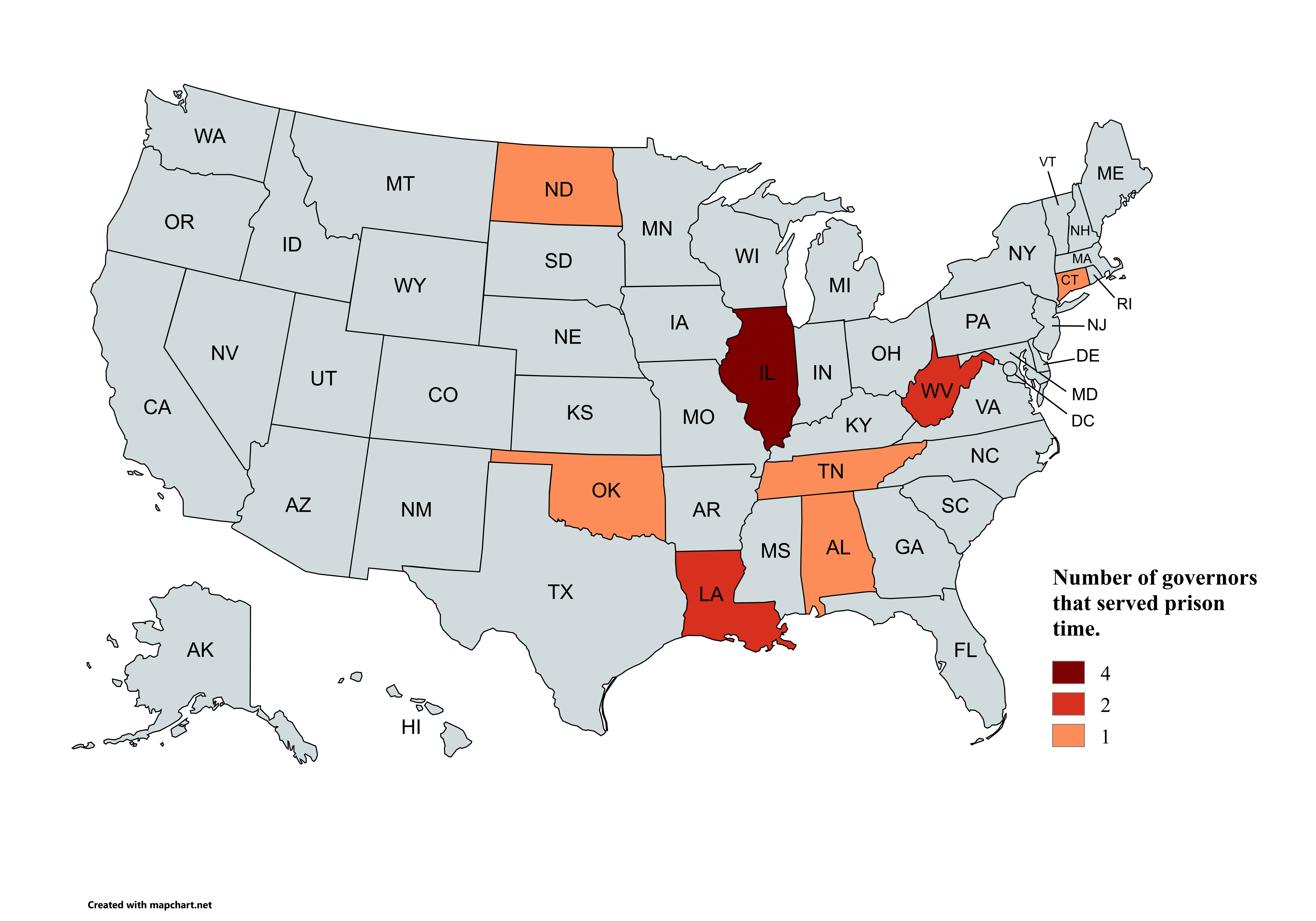Map of Governors Who Served Prison Time


Alex Cartwright
Senior Cartographer & GIS Specialist
Alex Cartwright is a renowned cartographer and geographic information systems specialist with over 15 years of experience in spatial analysis and data...
Geographic Analysis
What This Map Shows
This map visualizes the sobering reality of political corruption in the United States by highlighting the governors who have served prison time. It brings to light a stark truth about political leadership in various states, revealing a pattern of misconduct that has led to incarceration. Notably, the map features governors from states like Illinois, Louisiana, and West Virginia, each with their own unique stories of political downfall.
Deep Dive into Political Corruption and Incarceration
The phenomenon of governors serving prison time often reflects deep-seated issues within the political system, including corruption, bribery, and abuse of power. History has shown that such misconduct is not confined to one region or political party; rather, it is a pervasive issue that transcends state lines. For instance, Illinois has been particularly notorious, with multiple governors, including Rod Blagojevich and George Ryan, facing prison sentences due to various corrupt practices.
Rod Blagojevich, who served as governor from 2003 until his arrest in 2008, made headlines when he was convicted for attempting to sell Barack Obama’s vacated Senate seat. His flamboyant personality and the shocking nature of his crimes captured national attention, making him a symbol of political corruption. George Ryan, his predecessor, was also embroiled in scandal, serving time for racketeering and fraud connected to state contracts.
Interestingly, other states have their own tales of political intrigue. Louisiana’s Edwin Edwards, who served as governor for four terms, was convicted on charges of racketeering, and Richard W. Leche faced similar fates for corruption. These cases highlight a recurring theme: the temptation of power can lead to disastrous consequences, not just for the individuals involved but for the public trust in government.
Beyond the individual stories, the impacts of these scandals extend into the realm of public perception and voter trust. When a state's governor is imprisoned, it can lead to a significant erosion of trust among constituents, with voters becoming increasingly skeptical of their elected officials. Moreover, these events often prompt calls for reform and greater transparency in government operations.
Regional Analysis
Diving deeper into the geographical patterns of governors serving prison time reveals intriguing contrasts between states. For example, Illinois, with its four imprisoned governors, stands out starkly compared to North Dakota, which has seen only one governor, William Langer, serving time. This discrepancy may stem from various factors, including political culture, regulatory frameworks, and the robustness of law enforcement in each state.
In Louisiana, the legacy of Edwin Edwards continues to loom large over the state's political landscape, while West Virginia's Arch A. Moore Jr. and Wally Barron represent a different flavor of political scandal, reflecting localized issues of governance. Tennessee's Ray Blanton and Connecticut's John G. Rowland show that corruption can strike in diverse political climates, further emphasizing that the issue is not restricted to any specific party or region.
Interestingly, Alabama's Don Siegelman remains one of the most notable examples of a governor being prosecuted for actions taken while in office, raising questions about political motivations behind such prosecutions. Each case carries its own narrative, shaped by local contexts, media coverage, and public reaction.
Significance and Impact
The implications of this map extend beyond mere statistics; they touch on the very fabric of democracy and governance in America. Understanding why governors end up in prison can illuminate broader systemic issues, such as the need for stronger ethics regulations and accountability measures. As political corruption continues to be a pressing issue, this map serves as a reminder of the potential dangers of unchecked power and the importance of vigilance among voters.
Furthermore, with increasing awareness of political corruption, citizens are beginning to demand more transparency and integrity from their officials. This trend is crucial in shaping future political landscapes, as public demand for ethical governance grows stronger. As we move forward, it’s essential to keep these narratives in mind, not just as cautionary tales, but as calls to action for a more accountable political system. Have you ever considered how these stories affect your trust in local leadership? The map serves as a stark reminder that governance is a responsibility that must be taken seriously, lest history repeats itself.
Visualization Details
- Published
- October 9, 2025
- Views
- 42
Comments
Loading comments...